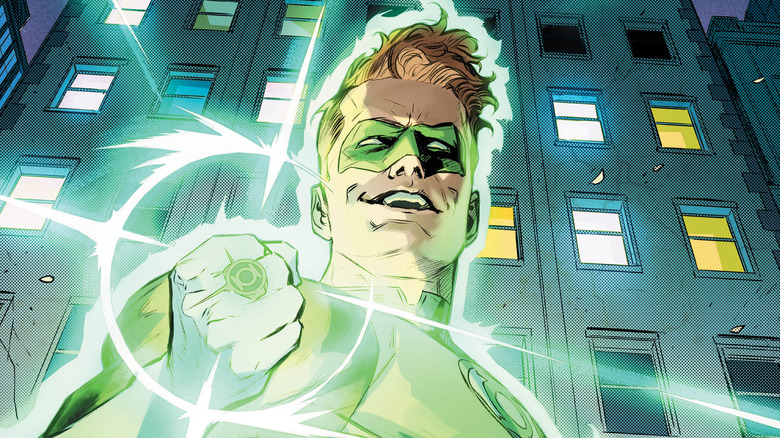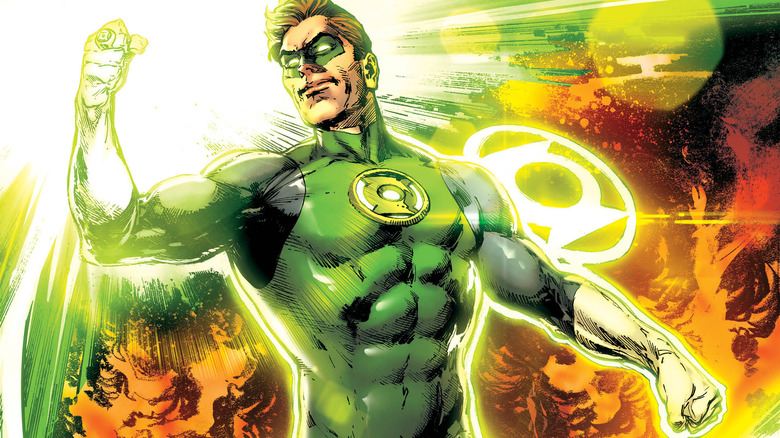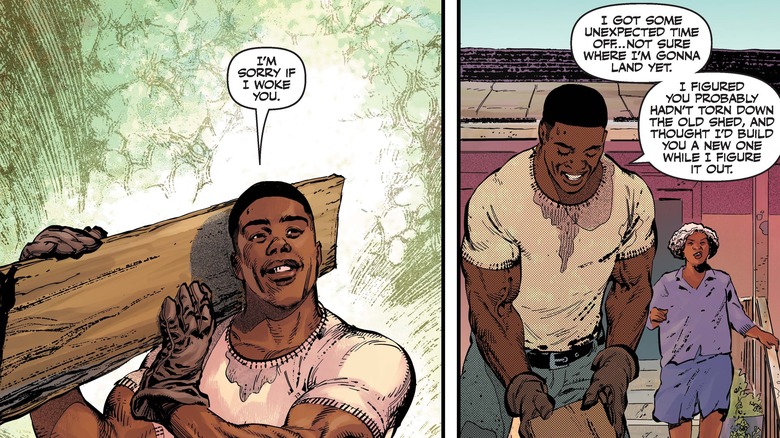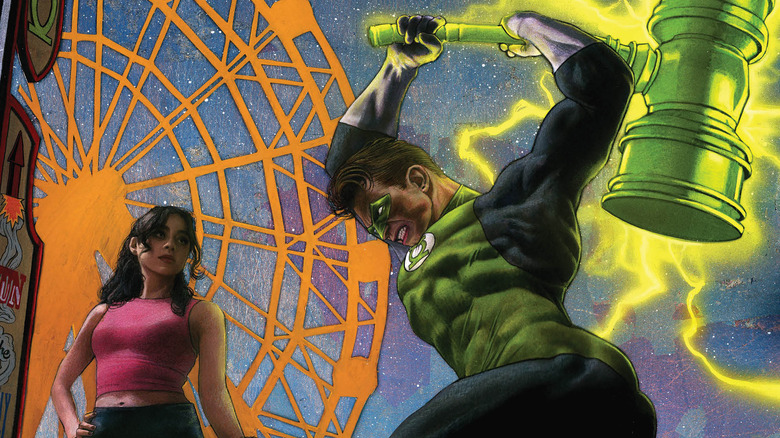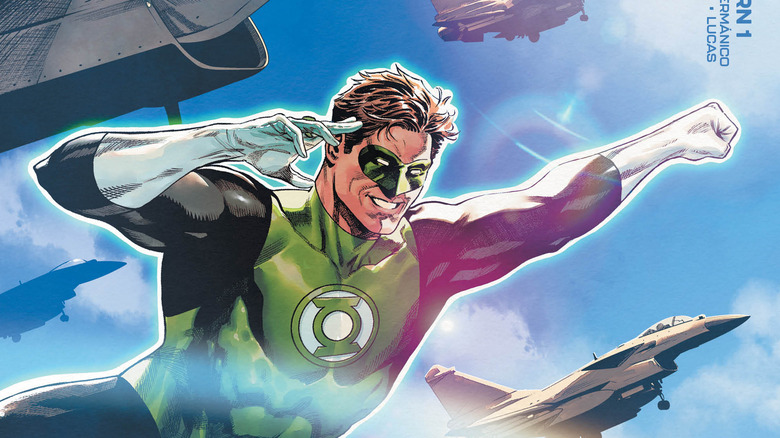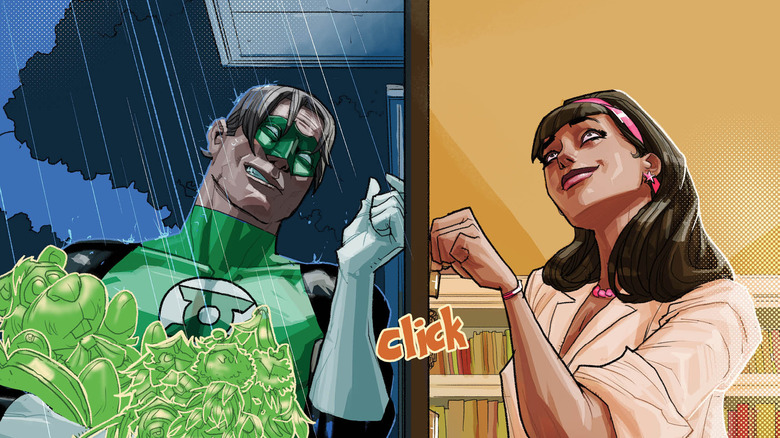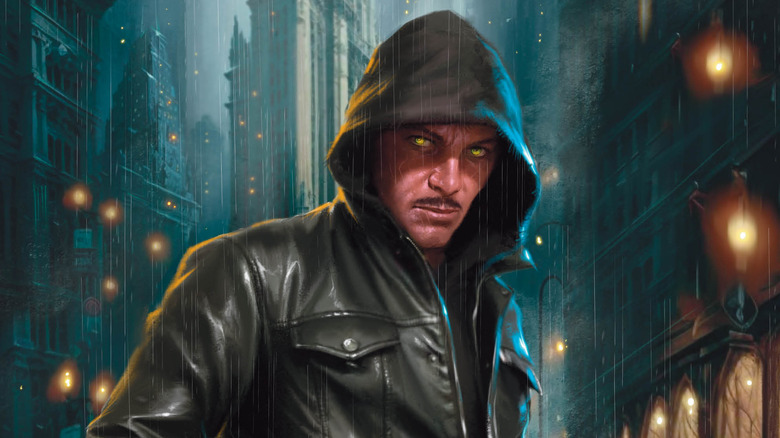Phillip Kennedy Johnson And Jeremy Adams Talk Green Lantern #1 - Exclusive Interview
Contains spoilers for "Green Lantern" #1
Hal Jordan and John Stewart are getting a much-deserved spotlight in a new comic with the newly released "Green Lantern" #1 from DC Comics.
While both Green Lantern stories find the popular heroes back on Earth and grounded from their usual space adventures, Hal and John will face two different major threats as they try to adjust to their new normal in the DC Universe. We spoke with writer Jeremy Adams, who is working on the Jordan-starring main series alongside artist Xermanico and colorist Romulo Fajardo Jr., and Phillip Kennedy Johnson, who is teaming up with artist Montos and colorist Adriano Lucas for a backup story featuring Stewart. They told us about launching a new era for Hal and John, what makes each Green Lantern hero so important, the collaborative process of writing two Lantern stories in the same series, and what readers can expect from the "Green Lantern" series in the future.
Where Hal Jordan and John Stewart start the series
Where does this book find Hal Jordan? Is he always destined to be a Green Lantern?
Jeremy Adams: That's the throughline of the first issue ... Is he a hero because this ring picked him, or is he a hero because that's who he is? This is him finding himself again, like, "How do I be Hal on Earth, but how do I ... What am I without this thing in the sky? What am I without Oa and the Green Lantern Corps?" By the end of the issue, it's like, "I know who I am. This is who I am."
But there's still a lot of self-discovery in terms of as a human being, "Who am I?" We live in a DC universe in which the legacy characters are growing up. What does that mean for the characters that have watched them grow up? How do you enter that next phase of your life when all the kids are now ... They've got families and you're still like, "Oh, man. My ex-girlfriend's got a boyfriend." He's faced with the reality on the ground, like, "How do I mature? Do I live here without running away?" Running away is probably easy, except now, he can't.
John Stewart has been off-planet for a while. What brings him back to Earth, and how is he finding being grounded?
Phillip Kennedy Johnson: He's dealing with a situation that he has seen a lot of his former, old men-at-arms in — the situation being coming back from service, having served in a super intense environment for a long amount of time, and coming home and having to retrain yourself how to move slowly again and how to live a normal life and how to ... He's trying to tell himself that he's not the guy anymore, trying to tell himself what his life's going to look like now.
The word that he's built around is "duty." He's the guy who does what he does for duty. Now, that duty is about his family and about finding what the next thing is going to be, and he tells himself, "This is where I need to be. Nobody else needs me anymore. I'm just a guy now." The universe has other plans ...
Why John Stewart is such a great Green Lantern
What was it like to continue John's journey, and what makes him one of the greatest Green Lanterns?
Johnson: To me, John is the guy that was always supposed to be a Green Lantern. He's the obvious choice. Hal is cool for such a different reason. They're both equally cool, but they're so different. I love that John is, in his way, the chosen one of Lanterns and he's all about service. He's the brilliant tactician, warrior, leader, architect — he's all the pieces. His greatest influence is his mother, who's this great civil rights leader. He's all about justice, duty, service, and all this stuff. There's also this eyes-in-the-sky, head-in-the-clouds pursuit of the thing that's greater than himself that I admire.
I recently went up to West Point [Military Academy] to teach a couple of things on writing to cadets. There was this guy who brought probably the cadet that was most excited to talk to the comic writer. He couldn't make all this stuff. I had a bunch of different engagements around. But this one guy couldn't make any of them because they are insanely busy all the time. They keep them jumping around the clock. But this guy finally made it ... He hauled ass over to the end of this one Q&A thing we did after dinner one night. He made it, and he brought some books for me to sign, and it was "Last God," something else.
But he was so excited, and he stuck around and kept asking questions until the guy who was taking me back to where I was staying was like, "Come on, Cadet, I could take you back to your barracks." He jumped in and got in the car with us and kept asking questions. He was a super nerd. Under the table, I was like, "Yo, here's my next thing." I'd just got the cover for "Dark Crisis: Green Lantern." He flipped s*** about it because his favorite character ended up being John Stewart, which I didn't know.
He lost his mind and went on at great length about why John Stewart was his favorite character. It's not because he looks like John Stewart, even though ... this guy did. His name is Monty Collins, I think, and he looks like John Stewart straight up. But that's not what he said. He loved that there was this guy in the Justice League who is also part of something bigger than the Justice League, bigger and older, and who's a part of something bigger. He went on about that. He talked about how West Point is where the concept of the class ring originated, which I didn't know, and how when he comes time to graduate, he's going to make his ring as close to the Green Lantern as he possibly can. Kid's a super fan, man, and he was trying to tell me why he loved John Stewart, but what he was really telling me is who he is, and why he is at West Point, and why he believes in the things he believes in.
That encapsulates who Monty might actually ... Well, I'm not going to say anything profane here, but it's going to mean a lot to him to hear this. To me, he represents John Stewart and why John's the greatest, and why I connect with that character so much. I have a very specific story I want to tell with John. I want to contrast him as much as I can with Hal Jordan; I want to show and explore how different they are.
Hal Jordan's relationship with Carol Ferris
How is Hal's relationship with Carol Ferris? Does Hal feel like he has something to prove?
Adams: Always. That's part of the reason he's back home. That's him trying to find his footing on Earth. Whether or not that works out remains to be seen, but anybody that leaves anywhere for a prolonged period of time and comes back home wonders, "Did I make the right decision? What about those relationships I left behind?" — especially somebody like Carol, who is so integral to Hal as a character and Hal as a human, somebody he's basically loved his entire life in some fashion.
The question I don't have the answer to yet is the regret of leaving that person — when you come back and that person's moved on, is it okay to try to insert yourself into that person's life? Is it okay? Is it necessary? Is it something that's supposed to be meant to be? I don't know. It's hard because we're dealing with comic books in which there are a million fandoms that have the people that love Carol, and the people that love Hal, and people that love them together, and people that don't love them together.
I listen to all that, but as I'm writing, I'm trying to figure it out organically. I don't want to force it. I look at it as more of ... Everybody remembers "Dawson's Creek," right? I always remember the fact that they built up this relationship between two characters, but there was this absolutely massive amount of chemistry between these other two characters. I want to allow for that possibility. But right now, Hal is very focused on, "Can I get this relationship back?" It means a great deal to him.
How important was it to give Hal Jordan the focus again?
Adams: As an uber-nerd, I love it. I love the push and pull of characters. I love the fact that Hal hasn't been around because that gives me an opportunity to reintroduce them to new readers, but also have this mission statement of, "I want people to like Hal." I want people to like Hal because I did see this weird ... People are like, "Ugh." He's a bit of a bland character sometimes where people can't say anything meaningful about him. He's the guy that shows up in "All-Star Batman" in a yellow room where Batman and Robin are like, "Ha, loser." I wanted him to be somebody cool. When Geoff Johns was doing "Green Lantern" and Peter Tomasi was doing "Green Lantern Corps," that was a huge, huge run for me. I remember going, "Oh my gosh. I could read each of these."
The fact that Hal is stationary on Earth gives a little different flavor. My goal is always to do something new or something that is slightly askew than what you've seen before. But more than that, I want people to get invested in Hal as a person. If we can do that, if I am successful at that — luckily, I have Xermanico. His characterizations are 1,000% better than I can write. But if people can get invested in that, then when you tell the stories and take them through a journey, it's going to mean so much more because we'll know who that person is rather than a caricature or, "He's tough guy Hal Jordan." I want some of that internal monologue. I want him to feel human and vulnerable in some ways.
Working with the artists to bring the stories to life
You've collaborated with Xermanico before. What made him the perfect artist for this series?
Adams: He is super dedicated to his craft. He'll go, "Here are five different versions of this panel. Which one do you think?" I can barely scratch out a stick figure, and somebody's asking me, "Which one do I think?" I'm like, "They're all amazing. I don't know." Having somebody that elevates everything you do ... My only goal — because it is such a visual medium — is I want it to be exciting for the artist ... I was nervous with this first script because I'm like, "People are talking too much. I need to give Xermanico something great." I want to service the artist in a way because I know that he's so amazing. It doesn't matter what you throw at him; it comes back 1,000% better.
What was it like to work with Montos and Adriano Lucas on this project? They do Cosmic Mayhem so well!
Johnson: Montos is not only great, he's so different from Xermanico, and ... I don't know. Everything about that first story looks, and feels, and sounds ... It feels like a Hal Jordan Green Lantern thing. It's so fun. It feels like test pilot stuff. The way he talks is perfect; the way it looks is perfect.
Having Montos in the back was such a great choice ... which I cannot take credit for. That was my editor who found him. He was like, "Here's this guy we're going to use, and he's going to be a star." I was like, "All right, let's check him out." I confess, I did not know his work. Seeing what he had done was ... I love the stuff that I saw that he had done, but this is better. This is the best work I've ever seen out of him. He's making everyone look ... All the real-life stuff, all the stuff on Earth, in the kitchen and out in the backyard, all looks so real. Then, we get to the crazy, cosmic, epic stuff and it looks just as real as all the other s***. It's incredible. It's so cool. I love seeing the stuff that Montos does.
Adriano is a consummate colorist. His work looks different on everyone he colors, and it suits this story so well. I'm totally spoiled on the artists. I love how different these two stories feel and how everyone's getting the purest Hal story [and] the purest John story. They're going to walk out here with their favorites, but they're getting top-shelf from both.
The collaboration between writers
How collaborative is this process between you? Do you guys exchange notes about, "Hey, I might be doing this. You won't be using this character"?
Adams: We started talking early on. I've only met [Phillip] in person once — was it New York?
We started talking about "Green Lantern," and I knew that Phillip was doing the backup, but he'd already done ... In "Dark Crisis," I had done a backup in [his] particular John Stewart story. I remember reading it and I'm like, "What is happening in this? This is insane."
When we were talking, and he was talking about what his plans were for John, and what my plans were for Hal, the structure of that ... I wrote up a document because I wanted to know where the Green Lantern Corps is and what's happening in the universe, so anybody that's touching Green Lantern can have a focal point, like, "This is what's happening," because I'm a continuity wh*** in a lot of ways. But I'm hoping — and we've talked about it — like, "How can we bring these characters together? How can we split them apart? How can we do that going on in the future?"
Johnson: This shared universe is such a cool thing, especially when you got working with such pros — talking to Jeremy all the time, talking to Josh [Williamson] all the time about the Superman stuff. I love all the story cross-pollination that we get to do, seeding in the little things that are happening in other books and finding ways to bring in other things and make everyone feel ... All the people who are getting all these different titles every month, [we want to] make them feel rewarded for that. Make them say, "I know exactly what this thing's talking about because I just read that," or, "This is coming out next week, and now I'm excited for it." That's the best.
Jeremy's story was coming out months before mine, and Jeremy had this big, high-concept thing that I wanted to know more about and figure out how ... Up to that point, my concept for the John story was more contained. I wanted to see how it would fit into the ideas that Jeremy had. That's the best, man. Comics feel the most like music when they're as collaborative as this has been. We're talking all the time. We're talking to the artists as much as we can, and the editors, and the writers of other books. When everyone's working together that way, and you're constantly tweaking to accommodate other people's visions, that's when it feels like you're making jazz.
Comics are interesting because you have to make and sell the bite-sized 20-page story, but it's also part of this much larger story that you're telling, and also a way larger story that DC is telling. You have to think about the micro and the macro constantly — and macro doesn't just mean macro. It's not just the body of your work for the next however many years; it's also the body of work that Jeremy's doing, and [other creators], and everyone else all at the same time. My first reference to the Radiant Dead in the comics was in "Action Comics." It was around the middle part of the "Warworld Saga."
Bringing back Sinestro
Sinestro has been teased in some of the previews of this book. How exciting is it to bring that villain back?
Adams: Paul [Kaminski], the editor, wanted Sinestro to be on Earth, too — not Earth-2, but Earth as well ... so I needed to figure out why he was there and what that was about, and the relationship between Hal and Sinestro is very important. What's cool is that we get a glimpse in Issue 1, and then "Knight Terrors" happens, and Alex Segura does a great, incredible backup with Sinestro, dealing with that, dealing with nightmares. That will hint heavily at the trajectory of Sinestro, and we are going to uncover why he's on Earth. That relationship between Hal and Sinestro will come to a head at some point.
What more can you say about the villains John Stewart is about to face?
Johnson: There's something really creepy and ominous and foreboding about the threat that doesn't just threaten — it also threatens to infect, to corrupt, to assimilate you. Something about that makes it that much extra horrifying. I don't know. It's things like the Borg in "Star Trek," or the Reavers in "Firefly," or to a lesser degree, the Sith, the way that the Jedi are always under threat of being turned. It's not the same, but those kinds of things ... The Borg is such a cool villain. It's this thing that grows and grows, [and] you can't ever destroy it because it's so much bigger.
They're scary as hell, and [that's] why they're super cool, why they're a very worthy villain for the Green Lanterns, and how they're their true opposite in similar ways that we saw, explored with things like the Sinestro Corps, and the Red Lanterns, and Black Lanterns. We've seen very effective takes on Lantern villains in the past, and the Radiant Dead has the potential to be just as cool.
What do you hope readers get from this first issue of your stories?
Adams: This is a unique opportunity because it's totally different than what I've been doing in "The Flash." This is a little different story. For me as a writer, that's exceptionally cool, but also terrifying because this is performative to a degree. All of it depends on the things that I want to do and enjoy. It also depends on if the readers respond to it, if I get to do it some more.
I'm having a ball. This is everything I've wanted to do since I was a little kid. I came to it backward through television and film, which is not necessarily the normal trajectory, and then trying to break into comics for years. Being here, it's like, "Oh." I really enjoy it, and I hope that people enjoy this, too, so that I keep doing it.
Johnson: People are going to buy this book and get two top-shelf-level stories for such different characters, and they're going to know who these characters are. You would not be able to imagine little stories happening to anyone else. Going forward, they're going to see other stories about those characters and be like, "That fits my vision for that character as established in 'Green Lantern' #1." That's great. Hopefully, we'll establish a lot of lore ... that other writers can then build upon and contribute to their mythology in a meaningful way.
"Green Lantern" #1 is available now.
This interview has been edited for clarity.
